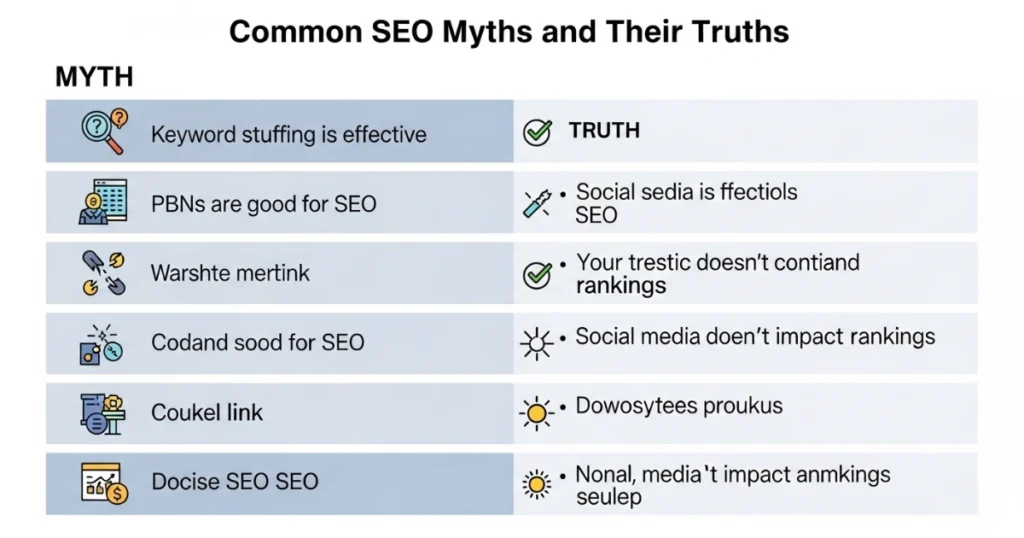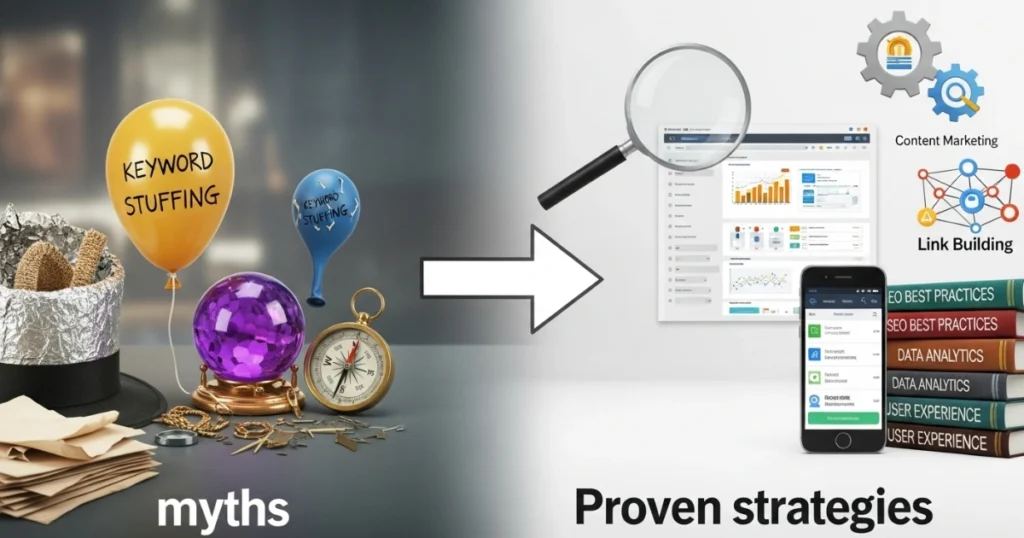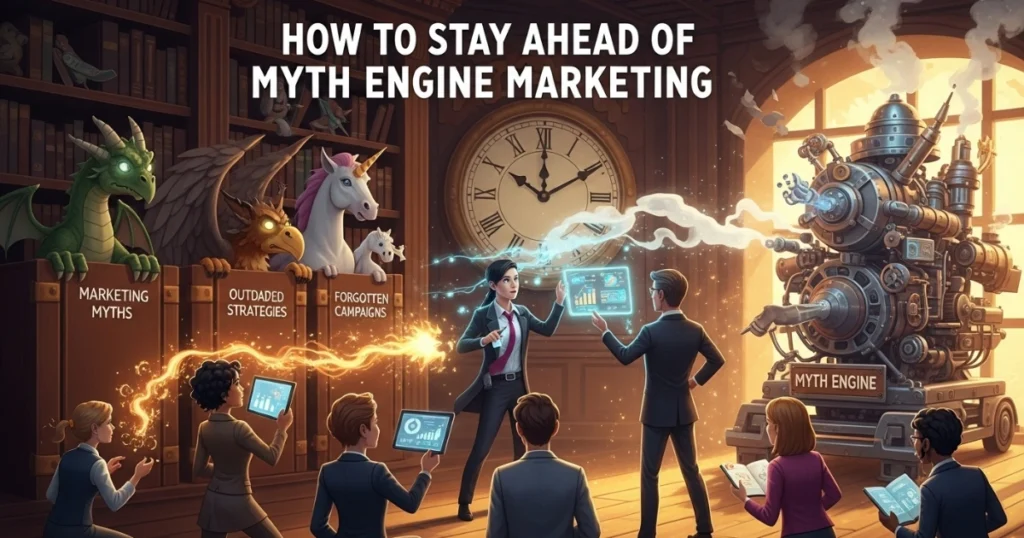
AI Commercials
Myth Engine Marketing: Top SEO Myths Debunked

Contents
In the ever-evolving world of digital marketing, myth engine marketing thrives as a persistent challenge, clouding the path to effective search engine optimization (SEO). Misconceptions about SEO strategies can derail even the most dedicated marketers, leading to wasted time and missed opportunities. Fortunately, by debunking these myths, businesses can unlock the full potential of their online presence. This article dives deep into the most common SEO myths, offering actionable insights to help you navigate the complexities of search engine algorithms. Moreover, we’ll explore proven strategies to enhance your website’s visibility while ensuring you maximize your efforts every time.
What Is Myth Engine Marketing?
Myth engine marketing refers to the widespread misconceptions and outdated beliefs surrounding SEO practices. These myths often stem from misinformation, old tactics, or misinterpretations of search engine algorithms. As a result, businesses may adopt ineffective strategies, hindering their ability to rank higher on search engine results pages (SERPs). By understanding and addressing these myths, marketers can focus on data-driven techniques that deliver measurable results.
For instance, many believe that stuffing keywords into content guarantees top rankings. However, search engines like Google prioritize user experience and content quality over keyword density. Consequently, dispelling these myths is crucial for crafting an SEO strategy that works.
Common SEO Myths and Their Truths

Myth 1: More Keywords Equal Better Rankings
One of the most persistent myths in myth engine marketing is that cramming keywords into your content will skyrocket your rankings. In reality, keyword stuffing can harm your site’s performance. Google’s algorithms, such as BERT and RankBrain, now focus on context and intent rather than sheer keyword volume. Instead of overusing keywords, aim for a natural flow that enhances readability.
Actionable Tip: Maintain a keyword density of around 1%, as we’ve done here, to ensure your content remains user-friendly. Use tools like Yoast SEO or SEMrush to analyze keyword placement and optimize effectively.
Myth 2: SEO Is a One-Time Task
Another common misconception is that SEO is a set-it-and-forget-it process. In truth, SEO requires ongoing effort. Search engine algorithms evolve constantly, and competitors adapt just as quickly. Therefore, regular updates to your content, backlink profile, and technical SEO are essential for sustained success.
Actionable Tip: Schedule monthly audits to review your site’s performance. Tools like Google Analytics and Ahrefs can help track changes and identify areas for improvement.
Myth 3: Backlinks Are No Longer Important
Some marketers believe that backlinks have lost their relevance in modern SEO. However, quality backlinks remain a critical ranking factor. Google views authoritative backlinks as votes of confidence, signaling your site’s credibility. Nevertheless, low-quality or spammy backlinks can lead to penalties.
Actionable Tip: Focus on earning high-quality backlinks from reputable sites in your niche. Guest posting, influencer collaborations, and creating shareable content can boost your backlink profile.
Myth 4: Social Media Directly Impacts SEO
While social media is a powerful tool for driving traffic, it doesn’t directly influence search engine rankings. This myth often confuses correlation with causation. For example, a viral social media post may increase site visits, indirectly boosting engagement metrics that search engines consider. However, likes and shares alone won’t improve your SERP position.
Actionable Tip: Use social media to amplify your content’s reach. Share blog posts, infographics, and videos to drive traffic and encourage natural backlinks.
Myth 5: Duplicate Content Always Leads to Penalties
The fear of duplicate content penalties is another pillar of myth engine marketing. While duplicate content can confuse search engines, it doesn’t automatically result in penalties. Google typically filters out duplicate content and prioritizes the original source. However, excessive duplication can dilute your site’s authority.
Actionable Tip: Use canonical tags to indicate the preferred version of a page. Regularly audit your site with tools like Screaming Frog to identify and resolve duplicate content issues.
Why Debunking Myths Matters

Understanding the truth behind myth engine marketing empowers businesses to make informed decisions. Misguided SEO practices waste resources and can even harm your site’s reputation. By focusing on proven strategies, you can align your efforts with search engine priorities, such as user experience, relevance, and authority. Moreover, staying updated on algorithm changes ensures your strategy remains effective over time.
For example, Google’s 2023 Helpful Content Update emphasized content created for users, not search engines. This shift highlights the importance of debunking myths that prioritize outdated tactics over user-centric approaches.
Proven SEO Strategies to Replace Myths
Now that we’ve debunked common myths, let’s explore actionable strategies to optimize your website effectively. These techniques align with current best practices and help you maximize your SEO efforts every time.

1. Prioritize High-Quality Content
Content remains the backbone of SEO. Search engines reward well-researched, engaging, and relevant content that addresses user intent. Therefore, invest in creating comprehensive blog posts, guides, and videos that provide value to your audience.
How to Do It:
- Conduct keyword research using tools like Google Keyword Planner or Ubersuggest to identify high-intent keywords.
- Write in-depth content (2,000+ words) that covers topics thoroughly.
- Use headers, bullet points, and visuals to improve readability.
2. Optimize for User Experience
User experience (UX) is a critical ranking factor. Metrics like page load speed, mobile-friendliness, and bounce rate directly impact your rankings. For instance, Google’s Core Web Vitals measure loading performance, interactivity, and visual stability.
How to Do It:
- Use tools like Google PageSpeed Insights to identify and fix speed issues.
- Ensure your site is mobile-responsive, as over 50% of web traffic comes from mobile devices.
- Simplify navigation to keep users engaged.
3. Build a Strong Technical SEO Foundation
Technical SEO ensures search engines can crawl and index your site effectively. Common issues like broken links, slow load times, or improper redirects can hinder performance.
How to Do It:
- Submit an XML sitemap to Google Search Console.
- Fix broken links and 404 errors using tools like Broken Link Checker.
- Implement HTTPS for secure browsing, as Google prioritizes secure sites.
4. Leverage Local SEO
For businesses targeting local audiences, local SEO is a game-changer. Optimizing for local search terms and maintaining a Google Business Profile can drive foot traffic and online conversions.
How to Do It:
- Include location-based keywords in your content and meta tags.
- Encourage customer reviews on Google and Yelp.
- Ensure your NAP (Name, Address, Phone Number) is consistent across directories.
5. Track and Analyze Performance
Data-driven decisions are key to overcoming myth engine marketing. Regularly monitoring your site’s performance helps you identify what works and what doesn’t.
How to Do It:
- Use Google Analytics to track traffic, bounce rates, and conversions.
- Monitor keyword rankings with tools like Moz or SEMrush.
- Adjust your strategy based on data insights to stay ahead of competitors.
The Role of AI and Automation in SEO

Artificial intelligence (AI) is transforming SEO, offering tools to streamline tasks and enhance accuracy. For example, AI-powered tools like SurferSEO analyze top-ranking pages to provide content optimization suggestions. Similarly, automation tools can schedule social media posts, monitor backlinks, and track keyword performance.
However, AI isn’t a magic bullet. Over-reliance on automation without human oversight can lead to generic content or misaligned strategies. Therefore, combine AI tools with human creativity to maximize results.
How to Stay Ahead of Myth Engine Marketing
To avoid falling prey to myth engine marketing, stay informed and adaptable. Follow these steps to keep your SEO strategy on track:

- Subscribe to Industry Blogs: Websites like Moz, Search Engine Journal, and Ahrefs offer up-to-date insights on SEO trends.
- Join Online Communities: Engage with SEO professionals on platforms like Reddit or LinkedIn to share knowledge and learn from others.
- Attend Webinars and Conferences: Events like BrightonSEO provide opportunities to learn from industry leaders.
- Experiment and Test: SEO is not one-size-fits-all. Test different strategies, such as A/B testing meta descriptions, to find what works for your audience.
Conclusion
Myth engine marketing can mislead even seasoned marketers, but by debunking common misconceptions, you can build a robust SEO strategy that drives results. Focus on high-quality content, user experience, and technical optimization to align with search engine priorities. Additionally, leverage data and AI tools to refine your approach and stay ahead of the curve. By replacing myths with proven tactics, you’ll maximize your SEO efforts and achieve sustainable growth. Start implementing these strategies today, and watch your website climb the SERPs!


Visual Style Lock: Creating Consistent Brand Aesthetics
Updated on September 5, 2025
Read More